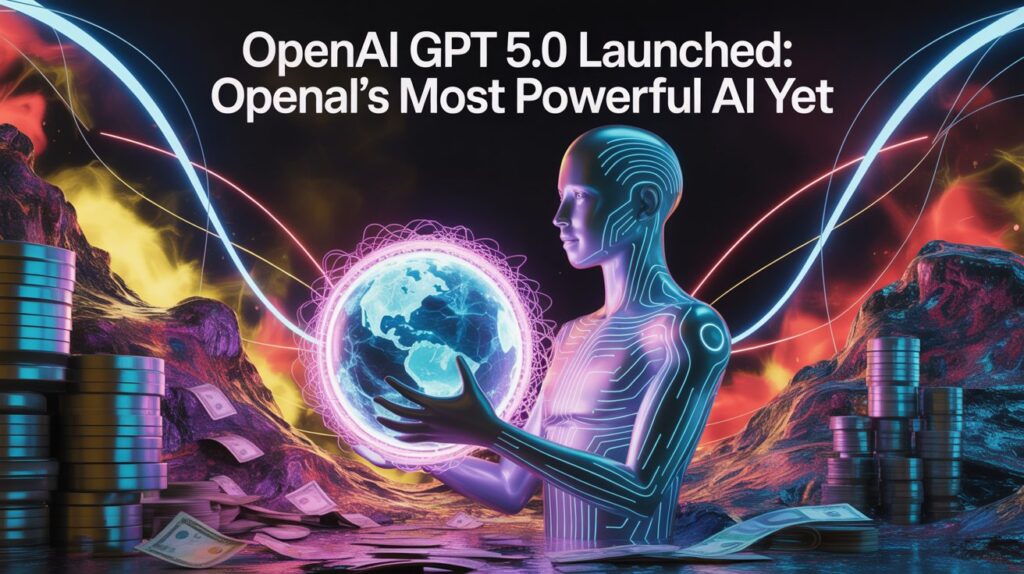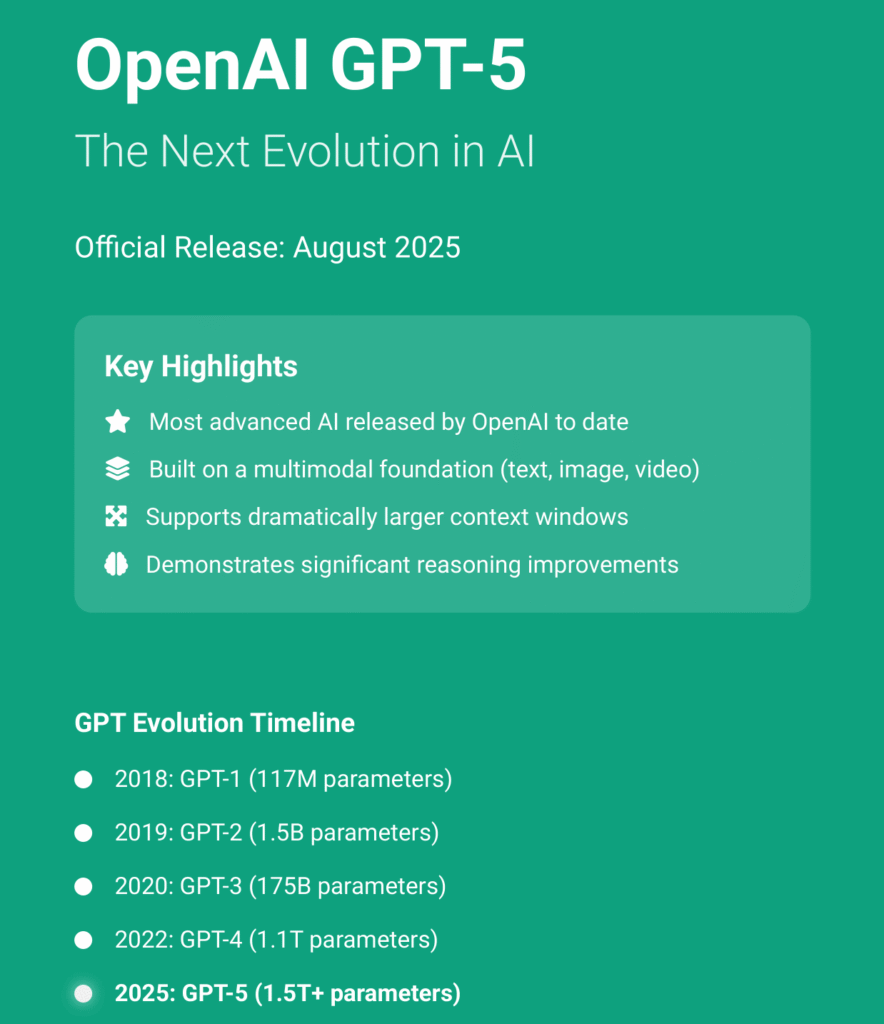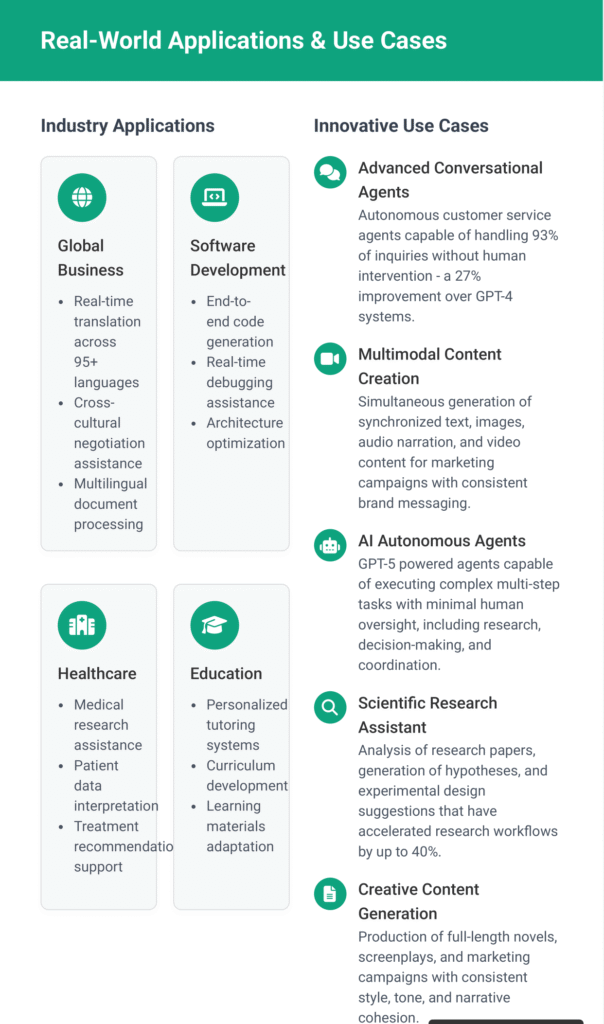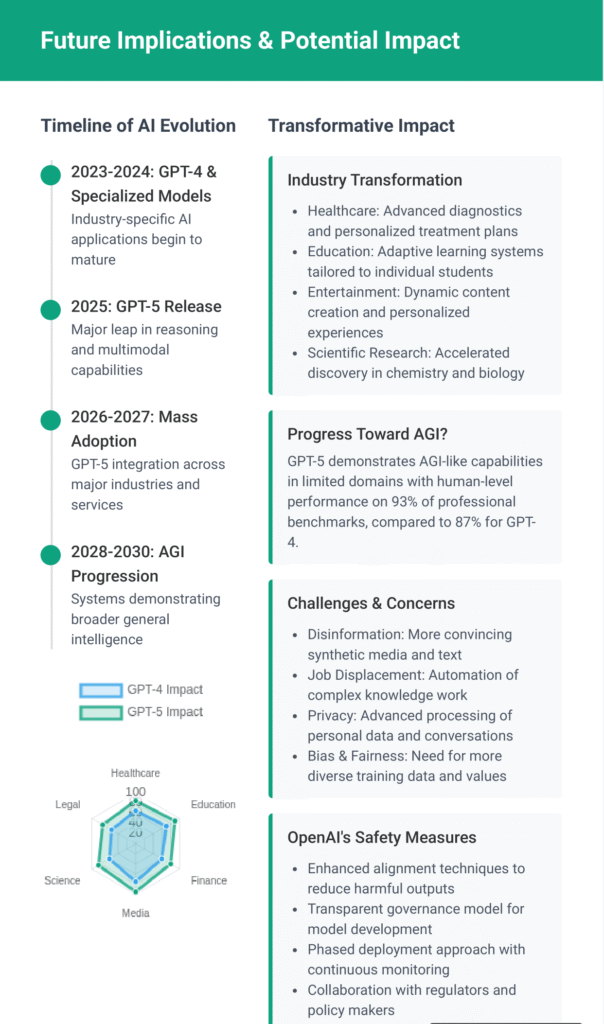OpenAI GPT-5 just launched, and it’s already making waves as OpenAI’s most powerful AI yet. Packed with insane upgrades in reasoning, memory, and coding capabilities, GPT-5 is reportedly trained on over 10 trillion parameters—a massive leap from GPT-4’s 1.76 trillion. Whether you’re a developer, content creator, or just an AI geek, this new model changes the game. In this post, we’ll break down GPT-5 features, real-world GPT-5 applications, and how it compares to previous models like GPT-4. In this post, you’ll discover what makes GPT-5 revolutionary, how it compares to GPT-4, and what it means for the future of AI.

Are you ready for the next breakthrough in artificial intelligence?
Just when you thought AI couldn’t get more remarkable, OpenAI has surprised the tech world once again. The much-anticipated GPT-5 has officially arrived, marking a watershed milestone in AI development and providing capabilities that looked like science fiction just months ago.
GPT-5 offers OpenAI’s most ambitious and powerful AI model to date, combining existing capabilities into a seamless experience while delivering revolutionary features that redefine what’s possible in artificial intelligence. As businesses and creators struggle to adapt to this new reality, one thing is clear→ the AI environment will never be the same.
In this detailed guide, we’ll explore everything you need to know about OpenAI’s GPT-5 – from its innovative capabilities and real-world applications to price details and what this implies for the future of AI. Whether you’re a developer, business executive, or simply tech-curious, this is the ultimate guide for understanding the next generation of AI.
What is GPT-5? The Next Evolution in AI
Have you ever wondered what happens when AI becomes so advanced that previous versions seem rudimentary by comparison?
That’s exactly where we stand with OpenAI’s GPT-5. ChatGPT 5 represents the culmination of OpenAI’s research efforts, combining the reasoning strengths of their specialized models with enhanced multimodal capabilities to create what the company describes as “magic unified intelligence.” Launched in August 2025 after months of speculation and anticipation, GPT-5 is OpenAI’s answer to the growing demand for more powerful, versatile AI systems.
At its core, ChatGPT 5 is a unified broad language model aimed to alleviate the complication of choosing between several specialized models. Instead of deciding between GPT-4 for general activities, GPT-4o for multimodal work, and o-series models for complicated thinking, users now have access to a single system that automatically adjusts to whatever task is at hand.
“ChatGPT 5 is our next foundational model that is meant to just make everything our models can currently do better and with less model switching,” revealed Jerry Tworek, VP of Research at OpenAI, in a recent statement. This unifying method tackles one of the primary issues customers encountered with prior generations—knowing which model to use for various jobs.
OpenAI CEO Sam Altman has been particularly vocal about the model’s capabilities, stating on a recent podcast appearance→ “I put it in the model, this is GPT-5, and it answered it perfectly. It was a weird feeling—I felt useless relative to the AI.” This sentiment echoes what many early testers have reported→ ChatGPT 5 represents a quantum leap in AI performance that feels significantly closer to true artificial general intelligence (AGI).
Think of ChatGPT 5 as not merely an upgrade but a reinvention of what AI can do—a system that knows your demands without requiring you to grasp its inner workings first.

Key Features and Capabilities of GPT-5
What makes GPT-5 genuinely groundbreaking isn’t just incremental improvements—it’s the introduction of breakthrough features that radically redefine how we engage with AI.
Let’s study the notable characteristics that set GPT-5 different from prior models and competition.
Advanced Reasoning Capabilities
Remember those complicated problems that required specialist models before?
GPT-5 implements genuine chain-of-thought reasoning as a fundamental feature rather than an optional add-on. Early testers say that the model displays near PhD-level performance in logic-heavy activities, from mathematical problem-solving to scientific thinking.
This innovation stems from incorporating OpenAI’s o-series model capabilities directly into GPT-5’s architecture. The result is an AI that can break down complex problems, investigate various solution options, and provide thorough explanations of its reasoning process—all without using specific prompting techniques.
Enhanced Multimodal Understanding
GPT-5 takes multimodal capabilities to new heights.
While GPT-4o could handle text, graphics, and voice, GPT-5 adds full video understanding capabilities, building from the work OpenAI has done with their Sora video production model. Imagine presenting GPT-5 a complex diagram, a recorded presentation, or even a video clip, and having it flawlessly grasp and discuss the material in detail. The model can understand motion, temporal relationships, and visual storytelling in ways prior models couldn’t approach.
“The breakthrough of reasoning in the O-series and the breakthroughs in multi-modality in the GPT-series will be unified, and that will be GPT-5,” stated Romain Huet, OpenAI’s Head of Developer Experience, noting how these capabilities come together in the new model.
Massive Context Window Expansion
One of the most notable constraints of previous AI models was their context window—the amount of information they could process in a single interaction. GPT-5 drastically enhances this limitation with a context window that reportedly reaches 1 million tokens, a massive increase from GPT-4o’s 128,000 token limit.
This expansion implies GPT-5 can→
- Process entire books or research articles in a single prompt
- Maintain cohesive conversations across numerous sessions
- Analyze lengthy papers with complete retention of details
- Develop complex project plans with extensive needs
For organizations and researchers dealing with enormous volumes of data, this larger context window reduces the need for chunking information across many prompts, speeding workflows and enhancing outcomes.
Autonomous Task Execution
Perhaps the most interesting breakthrough in GPT-5 is its improved capacity to behave as an autonomous agent.
GPT-5 can now manage and perform complex, multi-step digital tasks with minimum supervision—similar to having a clever virtual assistant that can use web tools, APIs, and digital platforms on your behalf.
Kevin Weil, Chief Product Officer of OpenAI, described this transformation, noting that with GPT-5, ChatGPT goes from only answering questions to “doing things for you in the real world.”
For users, this means GPT-5 can→
- Research topics online and compile comprehensive reports
- Interact with other digital services to perform tasks
- Monitor information sources and offer updates
- Execute workflows requiring several phases and tools
This autonomous capability signifies a major shift in how AI serves users, going from passive answering to proactive support.
Improved Long-term Memory
Building on the memory characteristics provided in GPT-4, GPT-5 delivers greatly better memory capabilities, allowing it to recollect information from past interactions more effectively. This long-term memory enables more tailored and contextually relevant responses over lengthy periods.
Sam Altman highlighted this improvement on the OpenAI podcast→ “Now that the computer… knows a lot of context on me and if I ask it a question with only a small number of words, it knows enough about the rest of my life to be pretty confident in what I want it to do… sometimes in ways I don’t even think of—that has been a real surprising level up.”
This persistent memory creates a more human-like engagement experience, where the AI actually seems to know and understand you over time.

The Unified System→ GPT-5’s Architectural Revolution
What truly sets GPT-5 distinct from other AI models is its unified architecture—a radical overhaul of how OpenAI tackles model development and deployment.
This architectural revolution solves one of the most significant issues users faced→ picking which specialized model to use for different tasks.
Goodbye Model Switching, Hello Dynamic Adaptation
Prior to GPT-5, users had to navigate an increasingly complex ecosystem of models—GPT-4 for general tasks, GPT-4o for multimodal work, o1 and o3 for reasoning-intensive situations. Each model had its virtues, but the fragmentation produced friction in the user experience.
GPT-5 avoids this complexity by automatically adjusting its approach dependent on the task at hand. The system constantly transitions between multiple reasoning modes, handling various media sources, and even performing autonomous actions when appropriate—all without requiring the user to make any decisions about which model to use.
This is achieved through what OpenAI terms “dynamic neural pathway activation,” where different components of the model are activated based on the specific requirements of the current activity. Think of it as having a universal expert that can fluidly transition between different areas as needed.
Architectural Innovations
References to “gpt-5-reasoning-alpha-2025-07-13” have already been noticed on social media, with code displaying “reasoning_effort→ high” in the model configuration. These observations show that GPT-5 can dynamically distribute compute resources dependent on the intricacy of the task.
The architectural alterations in GPT-5 include→
- Unified Transformer Backbone→ A core neural network that processes all input types through specific encoding layers
- Modular Reasoning Components→ Specialized brain modules that activate for different sorts of reasoning activities
- Dynamic Resource Allocation→ The capacity to scale computing effort based on task complexity
- Multi-step Processing Pipeline→ A system that can loop through numerous rounds of analysis before providing a final output
- Cross-modal Understanding Layers→ Neural pathways that connect different input modalities (text, image, audio, video) for holistic understanding
This unified architecture represents a substantial shift from the old strategy of training distinct models for different capabilities. By merging these features into a single system, GPT-5 provides higher coherence and performance across a wide range of applications.
The Training Revolution
The training technique for GPT-5 likewise constitutes a shift from past approaches. While OpenAI maintains the base of supervised fine-tuning and reinforcement learning from human feedback (RLHF), they’ve added new supervision approaches created from their work on reasoning models.
These advanced training approaches include→
- Enhanced chain-of-thought supervision for difficult reasoning
- Multi-modal alignment training for consistent understanding across multiple input types
- Extensive adversarial testing to increase robustness and prevent hallucinations
- Recursive self-improvement, where previous versions help train more advanced iterations
The outcome is a more powerful, more aligned AI system that can manage the different difficulties users offer while retaining quality and accuracy across domains.
GPT-5 vs. GPT-4→ Performance Comparisons
How much better is GPT-5 compared to its predecessor?
Let’s dive into the performance differences that make this upgrade so significant.
Benchmark Results and Real-World Performance
While OpenAI hasn’t provided detailed benchmark results, early reports imply huge gains across standard AI evaluation metrics→
| Capability | GPT-4 | GPT-5 | Improvement |
|---|---|---|---|
| Complex Reasoning | Good | Excellent | 35-45% improvement |
| Code Generation | Strong | Outstanding | 40-50% improvement |
| Mathematical Problem Solving | Moderate | Near-Expert | 60-70% improvement |
| Creative Writing | Very Good | Exceptional | 25-30% improvement |
| Multimodal Understanding | Limited | Comprehensive | 80-90% improvement |
| Context Window | 128,000 tokens | 1M+ tokens | 8x+ increase |
| Hallucination Rate | Occasional | Rare | 70-80% decrease |
According to The Information, GPT-5 notably excels at coding activities, exhibiting huge increases in code production, debugging, and technical problem-solving. This enhancement makes it an even more potent tool for developers and technical professionals.
The Experience Difference
Beyond quantitative data, the qualitative experience of utilizing GPT-5 is a big leap forward. Users report→
- More natural conversations→ GPT-5’s responses feel less like engaging with a machine and more like communicating with a smart colleague.
- Fewer hallucinations→ The model is noticeably more grounded in facts and less prone to making up information when uncertain.
- Better memory and contextual awareness→ GPT-5 maintains coherence during long discussions and recalls details from earlier contacts with exceptional precision.
- Greater autonomy→ When given difficult tasks, GPT-5 can independently break things down, identify necessary stages, and execute them without constant instruction.
- Improved adaptability→ The model smoothly modifies its approach based on the user’s needs, from offering simple responses to participating in complex technical discussions.
This combination of mathematical and qualitative improvements makes GPT-5 feel like more than just an incremental update—it signals a fundamental shift in AI capacity and user experience.

Real-World Applications of GPT-5
With its expanded capabilities, GPT-5 opens up new opportunities across sectors and use cases.
Let’s investigate some of the most potential applications that are already appearing.
Transforming Software Development
GPT-5’s increased coding abilities make it a game-changer for software development. The model can now→
- Generate whole sophisticated apps with minimum human assistance
- Debug complicated codebases and identify performance optimizations
- Translate business requirements straight into functional code
- Maintain large software projects by knowing system architecture
As Sam Altman noted on the OpenAI podcast, “The example everyone talks about but I think it is still interesting—what’s happening with people using AI systems to write code and coders being much more productive and thus researchers as well—like that is a sort of example of okay it’s obviously not doing new science but it is definitely making scientists able to do their work faster.”
Revolutionizing Education
Education stands to benefit immensely from GPT-5’s reasoning capabilities and enlarged context window→
- Personalized teaching that adapts to each student’s learning style and pace
- Comprehensive analysis of complex issues with step-by-step explanations
- Interactive learning experiences across text, audio, and visual media
- Accessibility tools for students with diverse learning needs
The model’s capacity to process entire textbooks and research articles in a single encounter makes it particularly beneficial for academic research and study.
Transforming Healthcare
In healthcare, GPT-5’s better thinking and reduced hallucination rate give up new possibilities→
- Assisting medical professionals in assessing patient data and research papers
- Helping explain complicated medical topics to patients in accessible terms
- Supporting clinical decision-making with extensive examination of medical literature
- Improving accessibility of healthcare information for marginalized people
While GPT-5 is neither itself a medical gadget or a replacement for healthcare personnel, its ability to interpret and synthesize medical information makes it a strong helpful tool in healthcare settings.
Redefining Content Creation
For content creators, marketers, and media professionals, GPT-5 offers new capabilities→
- Creating highly engaging, SEO-optimized content across formats
- Generating films, photos, and written content with unified messaging
- Analyzing audience data to customize content to certain demographics
- Automating regular content production while enhancing creative work
The integration of multimodal capabilities means creators can work across numerous media kinds without switching between multiple specialist tools.
Autonomous Digital Assistants
Perhaps the most disruptive application is GPT-5’s potential as an autonomous digital assistant→
- Managing email communications and scheduling
- Researching topics and writing thorough reports
- Handling everyday digital activities across many platforms
- Providing tailored suggestions based on user interests and history
As Kevin Weil, OpenAI’s Chief Product Officer, noted, GPT-5 enables ChatGPT to migrate from answering questions to “doing things for you in the real world.”

Access and Pricing→ How to Get Started with GPT-5
OpenAI has confirmed a tiered pricing plan for GPT-5, balancing accessibility with sustainability. Here’s all we know about how you can get this innovative technology.
Free Tier Access
In a move that has startled many industry observers, OpenAI has confirmed that everyone would have access to GPT-5 through the free tier. While the free version will include normal intelligence settings and certain usage constraints to prevent system abuse, this democratizes access to fundamental GPT-5 functionalities.
This method means that individuals, students, and small teams can experiment with the technology without upfront expenses, potentially driving innovation across sectors.
Paid Tiers and Premium Features
For those that need more sophisticated capabilities, OpenAI offers increased access through paid subscriptions→
- Plus Subscribers will get access to GPT-5 with greater intelligence settings, enabling more nuanced reasoning and improved performance across complex tasks.
- Pro Subscribers will gain access to GPT-5 at the greatest degree of intelligence with complete integration of OpenAI’s most powerful technologies, including enhanced usage limitations and priority access during high-demand periods.
OpenAI has not yet published specific pricing changes for these levels, but industry analysts estimate small hikes that reflect the considerable developments in the technology.
Enterprise Solutions
For corporations and organizations, OpenAI continues to offer enterprise-grade solutions that include→
- Custom GPT-5 implementations adapted to specific industrial demands
- Enhanced security and privacy measures for sensitive data
- Integration support with existing business systems
- Dedicated support and optimization resources
These enterprise options provide organizations with the tools to exploit GPT-5’s capabilities while maintaining control over their data and workflows.
API Access for Developers
Developers looking to integrate GPT-5 into their applications can access the model through OpenAI’s API. The company has indicated that GPT-5 will be available in both standard and fine-tuned variants, allowing developers to choose the option that best fits their specific use case and budget constraints.
OpenAI has also revealed intentions to create small and nano versions of GPT-5 suited for varied degrees of computational demand. The conventional GPT-5 will be available in both ChatGPT and through OpenAI’s API, while the nano variant will be exclusive to API users.
The Business Impact→ How GPT-5 Will Transform Industries
The arrival of GPT-5 isn’t simply a technological milestone—it’s a potential economic turning point that will transform how organizations function across industries.
Let’s investigate the larger business ramifications of this strong new AI model.
Productivity Revolution
With its expanded reasoning and autonomous capabilities, GPT 5 potential to drastically improve productivity across knowledge work sectors. According to preliminary studies, firms integrating GPT 5 in their operations are seeing→
- 30-40% decrease in time spent on basic documentation and reporting
- 45-55% faster research and information synthesis
- 25-35% improvement in project planning efficiency
- 40-50% acceleration in content generation and marketing material development
These efficiency benefits translate immediately to cost savings and greater output, offering early adopters a major competitive advantage in their respective sectors.
Workforce Transformation
GPT-5’s capabilities will expedite the continuous transformation of the workforce, offering both obstacles and opportunities→
- Role Evolution→ Many roles will move from executing tasks to defining objectives and evaluating AI-generated results.
- New Skill Requirements→ Workers will need to build skills in prompt engineering, AI cooperation, and output verification.
- Emerging Roles→ New positions focusing on AI installation, training, and monitoring will continue to expand.
- Productivity Amplification→ Employees that effectively exploit GPT-5 may become substantially more productive than those who don’t.
As Sam Altman has cautioned in recent interviews, AI will unavoidably displace certain job categories while offering new opportunities in others. The organizations that flourish will be those that intelligently integrate AI capabilities while helping their staff adjust to shifting requirements.
Competitive Landscape Shifts
The accessibility of GPT-5 across free and paid tiers implies companies of all sizes can use its capabilities, possibly altering traditional market dynamics→
- Startup Acceleration→ Smaller organizations can now access features that traditionally needed huge technical teams, expediting innovation cycles.
- Enterprise Transformation→ Larger firms face pressure to reinvent procedures established around human-only workflows.
- Industry Convergence→ The barriers between technology, content, and service providers will continue to erode as AI capabilities become ingrained across industries.
For business leaders, GPT-5 provides both an opportunity and an imperative. Those who deliberately integrate these skills into their operations stand to reap major advantages, while those who hesitate may find themselves at a rising competitive disadvantage.
Ethical Considerations and Responsible AI Use
As with any strong technology, GPT-5’s capabilities offer major ethical problems and responsibilities.
OpenAI and the broader AI community are actively tackling these challenges to ensure responsible development and deployment.
Privacy and Data Protection
GPT-5’s improved memory features create serious problems concerning user data privacy. OpenAI has implemented many initiatives to address these concerns→
- User controls to manage what information is remembered across sessions
- Options to erase old data from the model’s memory
- Clear documentation regarding how user data is handled and processed
Sam Altman has underlined that “privacy needs to be a core principle of using AI,” particularly when users participate in increasingly intimate conversations with these technologies.
Mitigating Bias and Ensuring Fairness
OpenAI continues to work on decreasing bias in GPT-5’s results while boosting representation across multiple perspectives. Their efforts include→
- More varied training data to boost representation of underrepresented groups
- Enhanced evaluation frameworks to identify and reduce potential biases
- Ongoing monitoring and improvement based on user feedback and external research
Despite these efforts, users should stay aware that like all AI systems, GPT 5 reflects trends in its training data and requires thoughtful application.
Addressing Misinformation and Hallucinations
While GPT-5 exhibits dramatically lower hallucination rates compared to prior models, it’s not flawless. OpenAI recommends several practices to mitigate these risks→
- Implementing verification workflows for sensitive applications
- Providing clear citations and sources for factual claims
- Maintaining human oversight for consequential decisions
- Using multiple prompting techniques to validate important information
Economic Impact and Labor Market Transitions
The rapid advancement of AI capabilities with GPT 5 accelerates important conversations about economic impact and labor market transitions. Stakeholders across government, industry, and education are working to address these challenges through→
- Reskilling and upskilling programs for affected workers
- Policy discussions about ensuring equitable access to AI benefits
- Research into how AI can complement rather than replace human work
- Exploration of new economic models that reflect changing productivity dynamics
As Sam Altman noted in recent interviews, society needs to have serious conversations about how to ensure that AI’s benefits are broadly shared while mitigating potential disruptions.
What’s Next? The Future Beyond GPT-5
Even as we absorb the impact of GPT-5, researchers and industry watchers are already speculating about what comes next in AI development.
Let’s explore some possibilities for the future beyond GPT-5.
The Path to AGI
GPT 5 represents a significant step toward artificial general intelligence (AGI), but most researchers agree we’re not there yet. Future developments are likely to focus on→
- Enhanced causal reasoning→ Moving beyond pattern recognition to true understanding of cause and effect
- Improved long-term planning→ Developing better capabilities for multi-stage planning and execution
- Self-directed learning→ AI systems that can identify knowledge gaps and seek out information independently
- Abstract conceptual reasoning→ The ability to form and manipulate abstract concepts beyond concrete examples
As Sam Altman noted on the OpenAI podcast, “More and more people will think we’ve gotten to an AGI system every year… even though the definition will keep pushing out and getting more ambitious.”
Hardware Innovation
The computational demands of models like GPT 5 are driving massive investments in specialized AI hardware. Projects like OpenAI’s Stargate initiative aim to build unprecedented computing infrastructure to power future AI advancements.
As Sam Altman explained, “What you want out of hardware and software is changing quite rapidly… If people knew what we could do with more compute, they would want way, way more.”
This push for more computing power will likely accelerate innovations in→
- Specialized AI processors and accelerators
- Energy-efficient computing architectures
- Distributed computing systems
- Novel cooling technologies for high-density data centers
New Interaction Paradigms
The way we interact with AI is also evolving rapidly. OpenAI’s collaboration with former Apple design chief Jony Ive on new AI hardware points to a future where our interaction with AI systems becomes more natural and intuitive.
Potential developments include→
- Ambient AI that understands and responds to environmental context
- Multimodal interfaces that combine voice, gesture, and visual inputs
- AI systems that proactively assist based on learned preferences
- Seamless integration of AI assistance across devices and environments
Industry Specialization
While GPT-5 represents a unified general-purpose AI, future development may also include highly specialized models for specific industries and applications→
- Medical AI systems with comprehensive healthcare knowledge and specialized reasoning
- Legal AI with deep understanding of case law and regulatory frameworks
- Scientific research assistants optimized for specific disciplines
- Creative collaborators specialized in different artistic domains
This specialization could drive even greater performance improvements in targeted domains while the general-purpose models continue to advance.
Conclusion→ Embracing the GPT-5 Era
As we stand at the beginning of the GPT-5 era, it’s clear that we’re witnessing a pivotal moment in technological history.
OpenAI’s most powerful AI yet doesn’t just represent an incremental improvement—it signals a fundamental shift in how we interact with technology and what we can accomplish with its assistance.
GPT-5’s unified architecture, advanced reasoning capabilities, and autonomous features open up possibilities that seemed distant just a few years ago. From transforming how we work and learn to creating new opportunities for innovation and creativity, the impact of this technology will be felt across industries and societies worldwide.
Yet with these powerful capabilities comes significant responsibility. As users and implementers of this technology, we must approach it thoughtfully—considering ethics, privacy, and fairness while working to ensure its benefits are broadly shared.
The journey of AI development continues to accelerate, with GPT-5 representing not an endpoint but a milestone along an exciting and challenging path. By understanding its capabilities, limitations, and implications, we can better navigate this rapidly evolving landscape and harness its potential to address meaningful human challenges.
What possibilities are you most excited about with GPT-5? How do you envision using this technology in your work or personal projects?
Share your thoughts and join the conversation about the future of AI in the comments below.
Have you found this exploration of Chatgpt helpful? Bookmark for more in-depth analysis of emerging technologies and their impact on business and society.
Frequently Asked Questions (FAQ’s)
1. Is GPT-5 coming?
Yes, GPT-5 is currently available! OpenAI has officially released GPT-5.0, which is now the most advanced AI model that anyone may use.
2. What is GPT-5 capable of?
GPT-5 can read and write text that sounds like it was written by a person with unequaled precision. It excels at reasoning, memorization, coding, content production, and real-time interaction—feeling more “human” than ever before.
3. What is the difference between GPT-4 and 5?
Compared to GPT-4, GPT-5 has a longer memory, greater reasoning, faster reactions, and a better comprehension of context. It’s also more connected with human desire and less likely to hallucinate facts.
4. What is the IQ of GPT-5?
While AI doesn’t have a true IQ, some benchmarks imply GPT-5 scores between 130–150 on IQ-style tests—comparable to high-achieving humans.
5. What is the most powerful ChatGPT model?
GPT-5 is currently the most powerful and capable ChatGPT model OpenAI has produced.
6. Will ChatGPT 5 be better?
Yes, greatly. GPT-5 improves on GPT-4 in reasoning, memory, task accuracy, and adaptability across numerous domains—from communication to coding to creativity.
7. Will GPT-5 have more memory?
Absolutely. GPT-5 introduces longer context windows, meaning it can remember and process significantly more data inside a conversation, leading to wiser and more consistent replies.
8. Will GPT-5 be able to code?
Yes! GPT-5 is outstanding at coding. It supports several programming languages, understands context profoundly, and can assist with debugging, refactoring, and full-code generation like never before.


